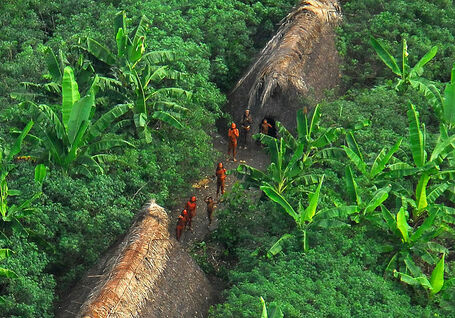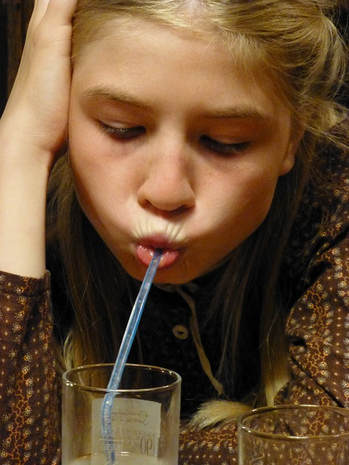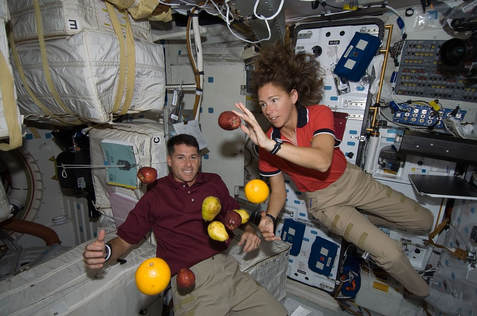 Isolated Tribe in the Amazon Isolated Tribe in the Amazon I have written that science can replace magical thinking, superstition, or erroneous ideas or beliefs by ever more refined and focused views of reality though observation and experiment. And this is essentially true. Science has done away with many beliefs and ideas that were not backed by facts. However, these changes rarely happen overnight, and in fact they are often met with stiff opposition. A significant number of people won’t modify their thinking based merely on piles of scientific evidence. If one of the purposes of performing science is to generate knowledge that will help people, then scientists have to take the beliefs and cultural norms of societies into account when pursuing the application of scientific knowledge. To illustrate this, let me tell you a story. A long time ago a physician friend of mine was working in the Amazon jungle. He was tasked with helping the local natives with their medical needs. At the time, an outbreak of malaria was decimating some of the local tribes. My friend told me the story of how he had traveled by boat up a river for several days and then hiked through the jungle to reach a particularly remote tribe. He contacted the tribe’s healer and explained to him that he had some medicine that could help protect the tribe against malaria, but that it was not strong enough by itself, so he needed the help of the healer. He explained that if they combined his medicine with the healer’s powers, they would be able to beat the malaria scourge that was affecting the tribe. So my friend proceeded to treat all the members of the tribe and the healer proceeded to make his potions and perform his dances and rituals, and all the individuals in the tribe affected with malaria were cured. On hearing this, I was astonished. Did my friend really think that the superstitious rituals and brews concocted by the tribe’s healer contributed or were needed at all to cure the malaria?
Now, let me be clear on two things. First, I agree that indigenous peoples throughout the world have developed a rich and effective arsenal of products derived from plants and animals in their environment to treat different ailments and conditions. Second, I also agree that in diseases that are self-terminating (i.e. those from which most people recover) the right psychological frame of mind can go a long way towards making individuals recover faster from their ailment. Even if a treatment is not really effective in curing a person, merely believing it is can make a difference in terms of how fast a person recovers their health. However, when it comes to certain extreme diseases, both indigenous medicine and psychology have limitations, and they cannot compete with medicines designed through evidence-based science. When I questioned my friend about these matters, he agreed with me that the healer’s traditional methods were not effective against malaria, but then he stated that that was not the issue. He explained that in tribes like the one he visited, the healer is a central figure in the hierarchy of the tribe. In the eyes of his fellow tribe members, the healer is so important in the role of protecting the tribe from dangers both real and imagined, that a healer who is perceived as ineffectual can deeply affect the psychology of the tribe and impair the way the tribe faces difficult challenges. My friend said that if he had barged right in and cured everyone, he would have delegitimized the healer in the eyes of the tribe and done a greater damage to the tribe than malaria. This is why he concocted the story about the need to combine both treatments. I was a bit shook up by this. I understood that from a practical point of view this approach made sense, but I remained ambivalent. I asked him, what about truth, facts, evidence, and reality? My friend replied that if enough people believe something no matter how preposterous, that belief for all practical purposes becomes a reality that you have to deal with if you are interested in helping out. If you go head on against these beliefs and disavow or belittle them, you will do more harm than good. I have thought about what my friend said over the years, and I believe it has some truth. People have deeply held beliefs that are often very important to them. From a scientific point of view, I may understand that some of these beliefs can be demonstrated to be false such as, for example, the belief in creationism, but I have to understand that the mere generation of more data and its repetition will not sway minds. And I think that this is a concept that should be applied (and is actually being applied) to the opposition against many of the initiatives that we need to implement today such as dealing with global warming or dealing with an increasing number of unvaccinated children. This is especially true in our current polarized environment, where scientists are portrayed by many with vested interests either as atheistic, liberal, socialist individuals who want the government to take over the lives of regular folk, or as individuals beholden to corporate interests who deliberately hide, falsify, or mischaracterize data. The success of the strategy I outlined above will depend on the approach. Very conservative and religious people will be suspicious of scientists warning them of how, unless we change our behavior, we will harm the planet. However, they may be more receptive if the focus is on the concept that humanity is the steward of creation; that we should take care of what God has created. This approach will be even more effective if it is implemented by individuals who share their own beliefs. A similar approach is also needed with people who are hesitant to vaccinate their children because they believe that vaccines cause autism. Many of these people have been swayed by stories of human suffering interpreted within the context of false or simplistic alarmist explanations. Data and facts are important in combating these false or misleading narratives, but the human side of the issue has to be addressed if scientists wish to change some minds. Scientists should acknowledge the parent’s fears and stress that the common goal of everyone is to protect children, and explain that’s why scientists vaccinate their own children. They should talk about the millions of people alive today because of vaccines, about how the world was when smallpox, diphtheria, pertussis, tetanus, polio, measles, mumps, rubella, and other diseases were prevalent in our societies. Again, these arguments will be more convincing if delivered by former vaccine opponents. The human mind is very complex. Different people perceive the same reality in different ways determined by genes, experience, and culture. Some of these perceptions will not conform to the actual veridical reality that’s out there, but as explained above, this in itself constitutes a reality that must be taken into account if we truly want science to help humanity. Whether it is helping a tribe in the Amazon or getting people to go green or to vaccinate their children, science cannot operate in a vacuum. Photo by Agência de Notícias do Acre used here under a Creative Commons Attribution 2.0 Generic license.
0 Comments
We often frame the way we react to and interpret reality based on what we experience. This perfectly reasonable approach, however, is not always accurate, and science can explain why. I will present some examples today and try not to sound too pedantic while doing it! Consider sunrises and sunsets. For millennia we have basked in the splendor of the spectacle of the sun rising in the morning and setting in the afternoon. That is our experience, right? The sun goes up and then down. How many poems and paintings and songs have been inspired by sunrises and sunsets? How many metaphors? The mere sight of the orb of the sun clearing the horizon or sinking below it has had a profound influence on the psyche of our species. The problem here is, of course, that the sun doesn’t “rise” or “set”, it is the Earth that turns! “Sunrises” and “sunsets” are just an illusion created by the fact that we are living on a rotating planet.  When drinking a beverage through a straw many people will claim to be “sucking” the liquid. If pressed to explain how the liquid gets from the container to their mouths, they will probable add that they create a vacuum inside the straw with their mouths and the vacuum “sucks” the liquid. This is not true. You have several hundred miles of air on top of you which generates a pressure at sea level of 14.7 pounds per square inch. This tremendous pressure is applied to everything including the drink and the air inside the straw. When you “suck” on the straw, your lungs expand creating a low pressure area inside them which is transmitted to the cavity inside the straw, and air moves from high pressure areas to low pressure areas. But in this case, the beverage is between the inside of the straw and the atmosphere. Thus the atmosphere pushes the liquid up the straw and into your mouth. The same happens with a vacuum cleaner. The motor creates a low pressure zone inside the machine by blowing air out, and the atmosphere pushes the air towards the inside. Sucking a liquid with a straw or operating a vacuum cleaner inside a room where the air has been removed (i.e. where the effect of the atmospheric pressure has been eliminated) would not work. Vacuums don’t suck. It is the atmosphere that pushes. How many people have asked others to shut a window or a door because they are letting the cold in (winter) or out (summer)? Here “cold” is being treated as an entity, and that is the problem. Cold doesn’t exist! The real entity is heat energy. Heat has a physical correlate (molecular vibrations) and can be measured (temperature is the measure of the heat content of something). At absolute zero (−459.67 °F), molecular motion ceases, there is no heat, and things can’t get any colder. What we perceive to be colder is something with less heat, and what we perceive to be warmer (or less cold) is something with more heat. Much in the same way that darkness is the absence of light and not a real entity in itself; cold is the absence of heat.  Let’s do one last one. We have seen videos of astronauts in the International Space Station (ISS) moving around their craft. Most people describe the astronauts as floating. Strictly speaking, this is not accurate, as for something to float it has to have a density lower than the medium surrounding it (think a balloon filled with helium released into the atmosphere). The astronauts pirouetting about the ISS are not less dense than the air that surrounds them, therefore they are not floating. At this point most people would clarify that the astronauts just appear to be floating. That is a fair reply, but when pressed as to why this is the case, many will answer that it is because there is no gravity in space. This is again not true. To understand why, imagine the following: you jump from a high diving board. During the few seconds before you hit the water are you floating? No, you are falling. Now imagine that as soon as your feet leave the diving board a room materializes around you, and this room has a camera in a corner. If I were to check the footage of the camera for the few seconds before you and the room hit the water, I would see you seemingly “floating” inside the room. But you are not floating, you are falling. Similarly, the astronauts inside the ISS are falling towards the Earth because they and the station are being pulled by gravity towards our planet. So why doesn’t the ISS crash and burn? This is because the station is moving at just the right speed to match the curvature of the Earth. As the ISS falls, the Earth curves, so the station and the astronauts inside it are always falling, but they never hit the ground. Gravity is alive and well in space. These are some cases of how our experience does not accurately describe the actual physical phenomena in the world that surrounds us. Can you think of any other examples? Please leave a comment, and let me know. Images from Pixabay used under a CC0 Creative Commons license. |
Details
Categories
All
Archives
June 2024
|
 RSS Feed
RSS Feed